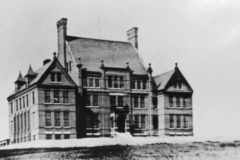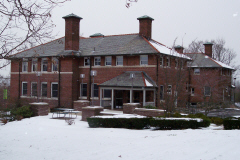|
Location and changing economy
Lyman School campus was near Lake Chauncey in the town of Westborough, on Powder Hill, off State Route 9. [11] It comprised about one thousand acres of which about five hundred were prime farmland, maintained by its students. The farm remained a principal means of support for the school until about 1955 when the economy of the region became predominantly industrial rather than agricultural due to the placement of major companies along State Routes 9. At that time, training of the students changed to adapt to the new economy. omega replica
Population established by courts
Students were sent to the Lyman School when the courts had determined that it would be in the public interest. Until about 1970, juveniles in the Commonwealth of Massachusetts were afforded none of the (now) commonly accepted Constitutional rights. Therefore, many boys were sent to this reform school for “crimes” such as truancy and being a stubborn child. In fact, an ancient law in the Commonwealth allowed stubborn children to be put to death. [1] It remained on the books even though it was never ostensibly invoked. Several famous criminals attended the Lyman School, one of them being the Boston strangler, Albert DeSalvo. However, most of the students were just ordinary boys who came broadside against the corrupt [2] Massachusetts juvenile court system, where such children were not allowed to have trials or to exercise other Constitutionally protected rights. [3,12]
Cottage system of administration
Swiss Replica Watches
|
The cottages were named for towns or places of geographical importance. In the 1950 to 1960 era, the cottages were Lyman Hall, Chauncey, Overlook, Sunset, Hillside, Wachusett, Worcester, Elms, and Oak. Lyman Hall was the induction center. All new students started there. Oak Cottage was the discipline cottage. Runaways, troublemakers, and returnees were put there for attitude adjustment. Cottage residents were usually graded according to age. The youngest boys lived in Chauncey Cottage and the oldest in Elms Cottage. The photograph of this subsection shows a typical cottage. This large building comprised two, Worcester and Westview.
Religious education
|
Society at the school
Historian Dick Bolt [5] is currently maintaining pictures and information about this school. Two authors are known to have attended the Lyman School and lived to write about it. They are Mark D. Devlin, [7] the author of Stubborn Child, who died in 2005, and Richard B. Johnson, [8] author of Abominable Firebug, who writes considerable details about students’ daily activities at the school.
The Lyman School was a nearly complete town in itself. It looked like a college campus. There were no prison walls or fences. It was, in fact, a completely open institution in which the residents were trained to remain in residence by a combination of education, honor, and fear of punishment. There were not even any locks on the doors of the cottages. Its students performed all of the maintenance, construction, and repair of the facilities. Trade masters supervised them. A student attending Lyman School would learn a trade whether he wanted to or not. It was not optional. The trades taught were grounds-keeping, laundry, cooking and other cafeteria skills, carpentry, painting, masonry, janitor work, electrical work, plumbing and steam-fitting, boiler maintenance, and printing. The entire official corpus of printed documents of the Commonwealth of Massachusetts, and all the government stationery, were printed in the Lyman School print shop. [3,4]
School studies
In the late fifties, the school comprised “Junior High” (grades 7 and 8) and “High School” (grades 9 and 10) classrooms. The Commonwealth of Massachusetts required students to attend school only to their 16th birthday so the 10th grade was the highest grade offered. The courses were highly regulated and highly regimented so that once a student returned to the community and a regular public school his knowledge would meet or exceed those who had attended regular schools. Failure to learn any subjects was not an option! Classes ran Monday through Friday. Work details and sports activity scheduled on the weekends. Every student, in addition to working in his assigned trade, would also participate in sports.
Students that excelled and needed to attend classes higher than the 10th grade enrolled in Westborough High School. A school bus picked them up in the morning and returned them after school. School classes started at 8:00 AM and ran to 12:00 noon. They started again at 1:00 PM and ran until 3:30 PM. Students reported to their trades-masters at 3:30 PM where they worked until 5:00 PM.
School history
The Lyman School for Boys has a less than pacific social history ranging from its nearly complete destruction by arson in its early years to runaways who were never caught nor heard from again. [6,15] Institutional folklore had it that missing runaways were not runaways at all, but children killed by the cottage or trade masters, with their bodies buried in the swamps behind the hill. [3,4] Just before its closure in 1971, there were rumors of staff committing atrocities against its residents. Although not supported by evidence, these rumors became part of Jerome G. Miller’s arsenal used to force the closure of this institution. [2]
New visibility
Approximately three hundred boys “graduated” from the Lyman School for boys every year. [3] Based on this figure, approximately forty-five-thousand boys have attended this institution. At least ten percent or about forty-five hundred should still be living in 2006. The public usually hears only about its failures, as in the case of the Boston strangler. This publicity bias makes it difficult to determine the correctness or effectiveness of such institutions.
Because of the stigma attached to attending “reform school,” the many successful businessmen who attended Lyman School for the most part remain silent, keeping their past attendance secret, perhaps in order to attain their rightful places in society. Often even close family members such as wives do not or did not know that their husbands attended this famous Massachusetts reform school.
A new awareness of the historical significance of this place, and the realization that many students at the school were forced to attend because of the corrupt Massachusetts juvenile justice system, and the absence of basic Constitutional rights for minors, [9,12] have led many prominent persons to announce that they too had attended this famous institution. Amongst them is Richard B. Johnson, [8] the author of Abominable Firebug and inventor, holding technological patents. Even while attending this school, Mr. Johnson invented what became known as the Rubber Ducky antenna. [10,13]
Closure
During the administration of Governor Endicott Peabody (1962-1965), various trade unions complained that maintenance of state-owned buildings at the Lyman School was being performed by non-union labor. If the trade unions were to have their way, the cost to the Commonwealth to maintain each student at the institution would increase from about five thousand to fifty thousand dollars per year. [2] Therefore, when Jerome Miller, [14] the new Director of the Youth Service Board, which had just changed its name to Department of Youth Services (DYS), closed this institution in 1971, there was little opposition. See Jerome G. Miller’s Last One Over the Wall [2] which describes his involvement with this institution’s closing.
References
1. A Brief History of Infanticide
2. Miller, Jerome G. (1991) Last One Over the Wall, Ohio State University Press ISBN 0-8142-0758-8
3. Johnson, Richard B. (2006) Abominable Firebug, iUniverse. ISBN 0-595-38667-9
4. Leaf, James G. (1998). “A History of the Internal Organization of the State Reform School for Boys at Westborough, Massachusetts (1846-1974),” Harvard University Doctoral dissertation
5. Richard “Dick” Bolt’s Lyman School history
6. Newspaper accounts of Lyman School
7. Mark Devlin’s biography
8. Richard B. Johnson’s biography
9. United States Department of Justice report on juvenile correctional facilities
10. Origin of the Rubber Ducky Antenna
11. Early Westborough history
12. The Juvenile court: changes and challenges
13. Rubber Ducky Antenna information
14. Jerome G. Miller’s fictional account of Lyman School
15. New York Times 1877 article on a riot at the Lyman School
Other Sources
Devlin, Mark (1985) Stubborn Child, Macmillan. ISBN 0-689-11476-1.
External links
Author’s website
Notes
This article may be freely copied or referenced. No copyright protection is claimed. The underlying HTML code is also in the public domain.


